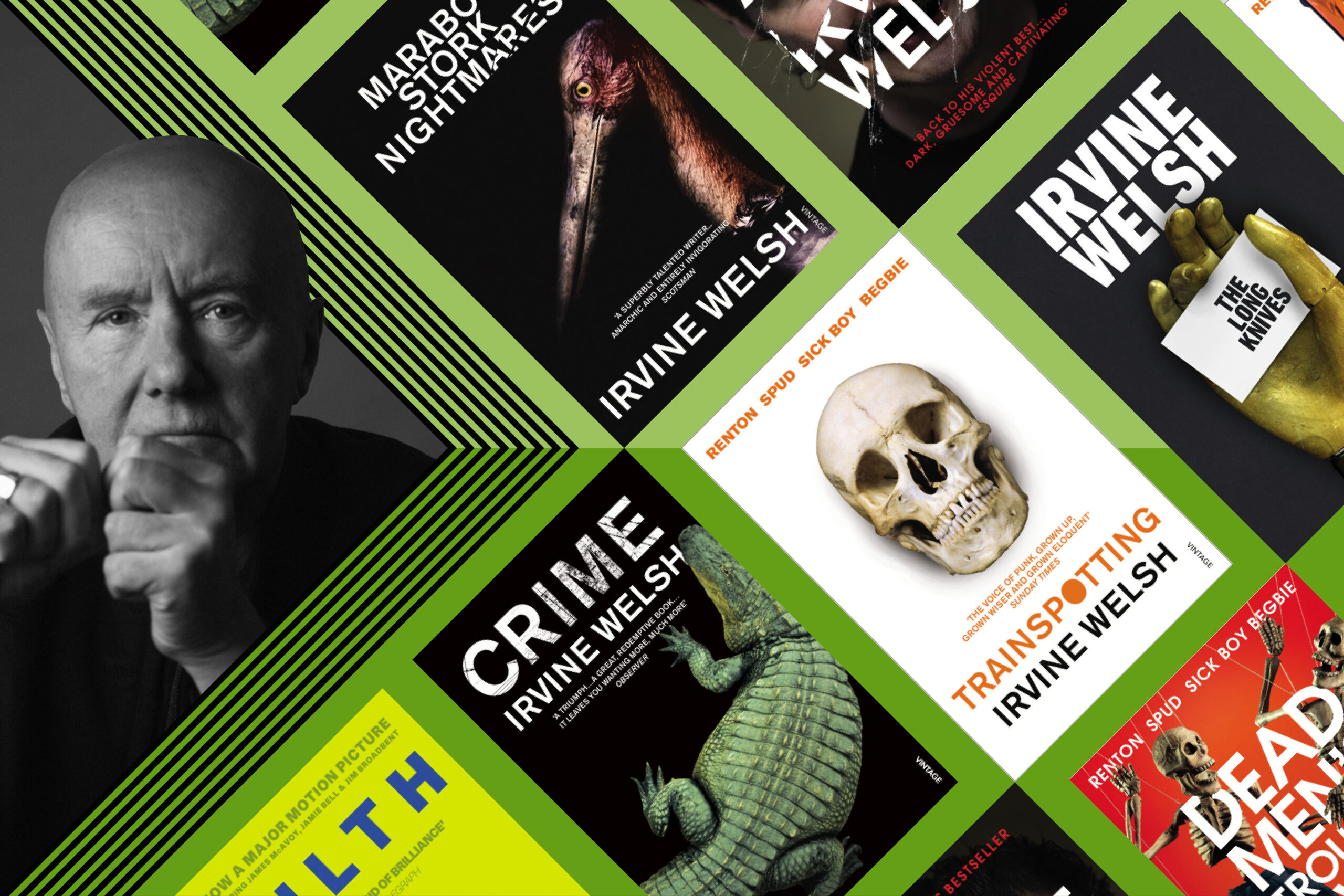Since he shook up the boring old book world 30 years ago, Irvine Welsh has enthralled millions of readers with his stories – the blackest of comedies, the trickiest of tragedies – often set in the housing estates of working-class Scotland. Like Nick Hornby before him and Helen Fielding after, Welsh has produced many imitators, but few equals – and he has outlasted them all. Here’s a guide on where to begin reading his strong, strange bibliography.
With the words “The sweat wis lashing oafy Sick Boy; he wis trembling,” Welsh’s unique style burst fully-formed onto an unsuspecting literary scene. His story of a crew of Edinburgh drug addicts, small-time crooks, out-and-out psychos and their blasted lives was a cult hit before Danny Boyle’s 1996 film adaptation sent it – and its star Ewan McGregor – into the stratosphere (or to America, anyway).
Behind his urban Scots demotic, the narrator Renton is articulate and sympathetic – he describes the shivers of going cold turkey off heroin as like “a thin layer ay autumn frost oun a car roof.” What Welsh brought to the book world with Trainspotting was not just new characters and a new voice but a new, young readership for modern fiction, which led to praise like this from literary journal Rebel Inc. : “The best book ever written by man or woman … Deserves to sell more copies than the Bible.”
Welsh showed his imagination and range with this novel which, like Trainspotting , continued to force readers out of their comfort zones. The anti-hero Roy Strang was brought up by a “genetic disaster” of a family on a tough Edinburgh housing estate (“a concentration camp for the poor”), suffered terrible abuses, and became a football hooligan. Now that he’s lying in a coma narrating his story, he’s unsure whether he’s really any worse off.
Marabou Stork Nightmares blends Welsh’s uniquely scabrous voice with elements from other modern Scots classics: the unusual structure of Iain Banks ’ The Bridge ; the typographical trickery of Alasdair Gray’s 1982, Janine . Roy’s feverish dreams about a time in South Africa and the killer stork he battles there provide a sinister but exciting account of the cycle of violence and how “it just goes round and round, the hurt.” But take nothing for granted in this novel, which keeps its final surprises right to the end.
By the time this novel was published, Welsh was such a hot property that one reviewer reported being offered cash in a bar for their advance copy of the book. The success he was enjoying, Welsh said, made him want to write something “completely incendiary, totally crazy,” and with Filth he delivered a novel that fulfils the promise of its title.
Detective Sergeant Bruce Robertson is Welsh’s most gruesome and grotesque narrator to date: violent, corrupt, sexually omnivorous and crippled with eczema and piles. His narrative of guilt and fear is interrupted by the voice of a tapeworm living in his gut, eating him up from inside and literally blocking out Robertson’s words on the page.
You might say that Filth explores the ever-current issue of mental illness, as the 2014 film adaptation more explicitly did, or the stain of racism in society – a Black journalist’s murder provides one plot point – but at heart it’s simply a chance for Welsh to provide the blackest of comedy from an anti-hero we love to hate.
This book may have another blunt monosyllable for its title, but it marks a departure for Welsh in more ways than one. The setting is mostly Welsh’s adopted home of Miami (where he’d return to in 2014’s The Sex Lives of Siamese Twins
Cop Ray Lennox, who was a secondary character in Filth , is taking a break to Florida to recover from dealing with a horrific child sex crime. “His thoughts are like a landslide,” but as he descends into a coke-fuelled bed-hopping spiral – how else would a Welsh character relax? – he realises his new pals are part of a paedophile ring.
The serious, sober treatment Welsh gives this distressing topic makes Crime a more restrained read than most of his novels, and it’s the book’s indelible moral core as much as the horror that keeps the pages turning.
Welsh has returned to the characters in Trainspotting before – in the sequels Porno Dead Men’s Trousers Skagboys
Some things don’t change though – Jim’s preferred artform is sculpting mutilated heads of celebrities (“My talent was for hurting people”), and when he learns that his son Sean has been murdered back in Edinburgh, it’s time for elements of the old Begbie to resurface. The Blade Artist reiterates Welsh’s point in previous novels that anger and violence in people come from something deeply buried – and while uncovering it may be ugly, it’s the only way to move on.
Fourteen years after Crime , Detective Ray Lennox is back in this sequel, which will form the second part of a trilogy. The book covers a long week in Lennox’s life, as he pursues the killer of MP Ritchie Gulliver. It’s not a straightforward task, given the number and range of enemies Gulliver’s corrupt, racist, vicious ways have earned him.
Welsh may be three decades into his career, but The Long Knives shows that his work has lost none of its visceral power to shock, from the opening scene of Gulliver suffering an amputation that will have every male reader crossing and recrossing their legs. And, as we see later in the book, that’s not the only thing being cut off without anaesthetic.
Switching tensely between Ray Lennox’s viewpoint and the voice of the killer, The Long Knives explores power, corruption and state-sponsored violence with all of Welsh’s trademark zest.
